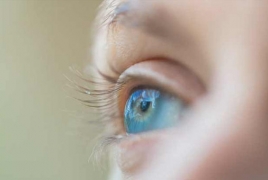Next-gen retinal implant could add years to your eyesight March 10, 2017 - 12:55 AMT PanARMENIAN.Net - In most cases of blindness, the majority of the eye is intact. The problem lies in the layer of light-sensitive cells in the back of the eye, called the retina. A variety of diseases lead to the degeneration of the retina, and vision decays along with it, even though the nerves that would take signals from the retina to the brain remain intact. There have been many ideas on how to use those nerves to restore some level of vision to people with retinal degeneration. These range from biological (using genetic engineering to make other nerve cells in the eye responsive to light) to electronic (using an external camera to send signals to an implant that activates the nerves). This week, researchers from Italy have reported something somewhere between the two: a photovoltaic polymer that acts as a replacement retina, no wires required, Ars Technica reports. The design of the new device is remarkably simple. The authors started with silk since it provides a biocompatible material that cells can grow around and attach to. On top of that, they layered a conductive polymer [poly(3,4-ethylene- dioxythiophene)-poly(styrenesulfonate)]. And on top of that, they added an organic semiconductor—poly(3-hexylthiophene)—that acts as a photovoltaic material under ambient light conditions. When implanted in the retina, incoming light would lead to a local buildup of charge, which should cause the underlying nerve cells to fire. To test this theory out, the authors used a breed of rats that is genetically prone to retinal degeneration. The researchers surgically implanted their device into the rat retinas so that it covered about 10-15 percent of the back of the eye. After giving the eye a chance to heal up, they tested whether the rats could respond to light. By every measure, they could. While their untreated siblings had severe vision problems due to retinal degeneration, those with the implants saw a degree of vision restored. For example, the authors tested the response of the animals' pupils, which should narrow when exposed to light. At very low intensity (one lux, a bit more than you'd get from a full Moon), the rats with the implants didn't show any more of a response than their untreated siblings. By four lux, however, the pupil closure was almost as strong as you'd see in a healthy rat. This sort of pattern—good, but not quite as good as the original retina—held for a variety of tests. These include the rats' tendency to avoid brightly lit areas and a response to a pattern that tested spatial resolution. The researchers were also able to determine that the visual cortex of the brain was activated by the implants. For these tests, they performed an implant in only one of a rat's two eyes. They were then able to show that the visual cortex on the opposite side of the head from the implant showed the activity. That's exactly what you'd expect, since the nerves from our right eyes extend to the left side of the brain and vice versa. There was also no sign of inflammation, and the implant remained in place for six months. While retinal implants had been tested previously, the first generation relied on external hardware with wires running into the back of the eye. Later versions also used photovoltaics, but they were sensitive to wavelengths or intensities of light that aren't common in daily life; one version even required an external laser to operate. They were often metallic or rigid as well. The surprising thing is that the authors aren't entirely clear how the generation of charges by the photovoltaic layer gets translated into nerve activity. Clearly it's working, but they admit that "the detailed principle of operation of the prosthesis remains uncertain." The other issue, of course, is that we can't ask a rat what it's seeing or compare its implant-driven vision to what it saw prior to retinal degeneration setting in. Still, there are a variety of other visual tests that can be done to tease out just how well these rats are seeing. And as some of the earlier generations of implants were tested in humans, there's a chance that something like this may eventually make its way into patients, Ars Technica said. Yerevan will host the 2024 edition of the World Congress On Information Technology (WCIT). Rustam Badasyan said due to the lack of such regulation, the state budget is deprived of VAT revenues. Krisp’s smart noise suppression tech silences ambient sounds and isolates your voice for calls. Gurgen Khachatryan claimed that the "illegalities have been taking place in 2020." Partner news |